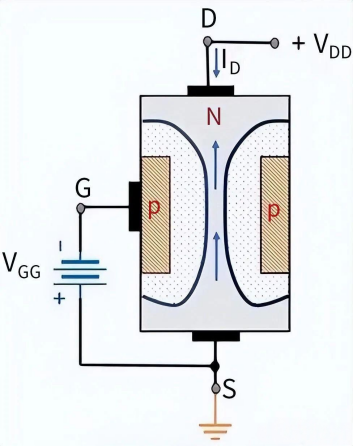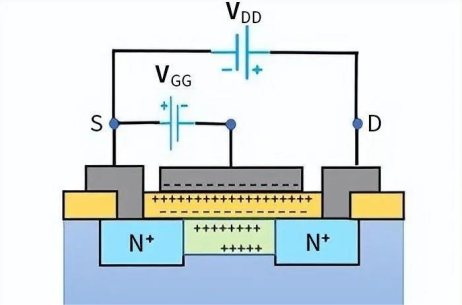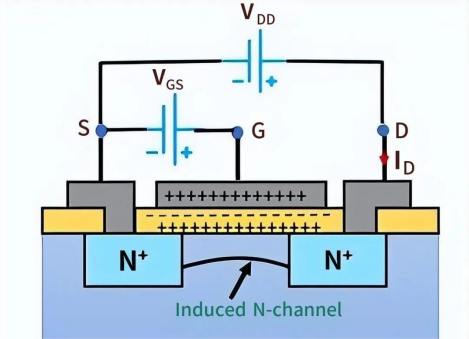
In the electronics industry, field-effect transistors (FETs) are key components widely used in amplification, switching, and signal processing circuits. While both JFETs and MOSFETs belong to the FET family, they differ significantly in structure, operation, and applications. This article explains the basics of JFETs and MOSFETs in an easy-to-understand way, highlighting their core differences.
Catalog
III. Key Differences Between JFET and MOSFET
I. What is a JFET?
JFET stands for Junction Field-Effect Transistor and has three terminals: gate, source, and drain.
In a JFET, the electric field applied to the gate terminal controls the current flow. The current from the drain to the source is proportional to the voltage applied at the gate.
JFETs generally come in two types: N-channel and P-channel. The voltage applied between the gate and source allows electrons to move from the source to the drain. This current is called the drain current (ID).

When the gate is negative relative to the source, the depletion region widens, allowing fewer electrons to move from source to drain compared to when there's no bias. Increasing the negative gate voltage further widens the depletion region, eventually cutting off the drain current completely.
JFETs are known for their long lifespan and high efficiency.
II. What is a MOSFET?
MOSFET stands for Metal-Oxide-Semiconductor Field-Effect Transistor. Like a JFET, its conductivity is controlled by voltage.
MOSFETs come in two main types: depletion-mode MOSFETs (D-MOS) and enhancement-mode MOSFETs (E-MOS).
· Depletion-mode MOSFET: A pre-built channel exists, and applying a gate-source voltage switches the device off.

· Enhancement-mode MOSFET: No pre-existing channel exists; applying voltage creates a conductive channel.

In D-MOSFETs, a negative gate voltage increases channel resistance, reducing drain current. In E-MOSFETs, operation requires a positive gate voltage to turn the device on.
III. Key Differences Between JFET and MOSFET
· JFET is a junction FET; MOSFET is a metal-oxide-semiconductor FET.
· JFET works only in depletion mode, while MOSFET works in both depletion and enhancement modes.
· JFET has two PN junctions; MOSFET has one.
· JFET is a three-terminal device; MOSFET is a four-terminal device.
· JFET doesn’t form capacitance in the channel; MOSFET forms capacitance between channel and gate.
· JFET manufacturing is simple; MOSFET manufacturing is more complex.
· JFET conductivity is controlled by reverse bias at the gate; MOSFET conductivity is controlled by induced carriers in the channel.
· JFET has high input impedance; MOSFET has extremely high input impedance.
· JFET has flatter characteristic curves; MOSFET curves are also flat but in a different range.
· JFET is normally-on; MOSFET is normally-off.
· MOSFET has a built-in body diode; JFET does not.
· JFET has higher gate current; MOSFET has low gate current.
· JFET has higher drain current; MOSFET lower.
· JFET gate is not insulated from the channel; MOSFET gate is insulated.
· Signal handling: JFET is more limited; MOSFET stronger.
· Cost and complexity: JFET is more expensive and complex to manufacture; MOSFET is easier and cheaper.
· Drain resistance: JFET higher; MOSFET lower.
· Leakage current: MOSFET lower than JFET.
· Popularity: MOSFET widely used; JFET less so.
· Applications: JFET for low-noise circuits; MOSFET for higher power and switching applications.
· Gate transconductance: JFET ~0.1–10 mA/V; MOSFET ~0.1–20 mA/V.
IV. Conclusion
In short, although JFETs and MOSFETs belong to the same FET family, their internal structure, working principles, and characteristics determine their distinct applications. JFETs shine in specific analog circuits thanks to their simplicity and low noise, while MOSFETs, with their extremely high input impedance and excellent switching performance, dominate digital electronics and power applications.




